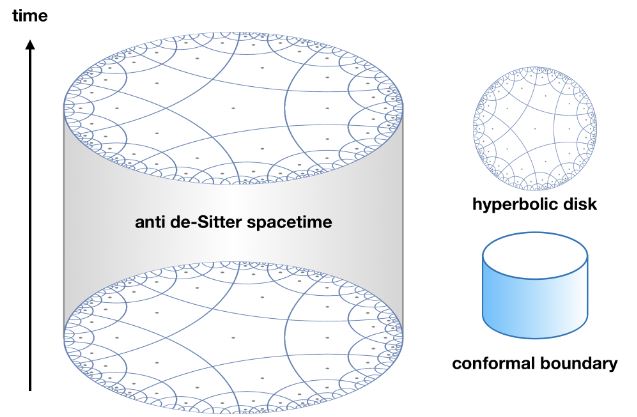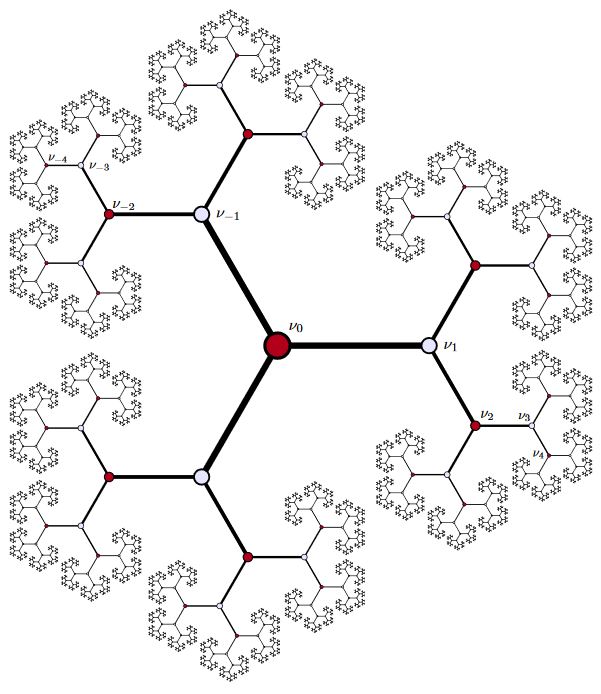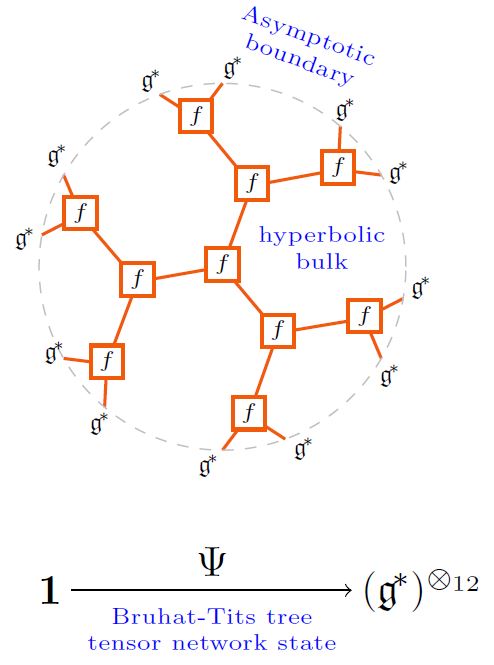nLab anti de Sitter spacetime
Context
Riemannian geometry
Gravity
Formalism
Definition
Spacetime configurations
Properties
Spacetimes
| black hole spacetimes | vanishing angular momentum | positive angular momentum |
|---|---|---|
| vanishing charge | Schwarzschild spacetime | Kerr spacetime |
| positive charge | Reissner-Nordstrom spacetime | Kerr-Newman spacetime |
Quantum theory
Contents

Definition
Up to isometry, the anti de Sitter spacetime of dimension , , is the pseudo-Riemannian manifold whose underlying manifold is the submanifold of the Minkowski spacetime that solves the equation
for some (the “radius” of the spacetime) and equipped with the metric tensor induced from the ambient metric, where denote the canonical coordinates. is homeomorphic to , and its isometry group is .
More generally, one may define the anti de Sitter space of signature as isometrically embedded in the space with coordinates as the sphere .
graphics grabbed from Yan 19
Properties
Coordinate charts
A comprehesive account of the AdS metric tensor in various coordinate charts is given in Blau §39.3.
Poincaré and horospheric coordinates (e.g. Blau §39.3.7). Consider the Cartesian space with its canonical coordinate functions
and denote its standard Minkowski metric tensor by
Moreover consider equipped with the pullback of the above coordinate function as well as with
Then there is a chart of of the form
such that the pullback of the AdS metric tensor is
This is the form of the AdS-metric which arises naturally as the near horizon geometry of black p-branes in supergravity (e.g. AFFHS98 (5)). The black brane singularity itself would be at .
In slight variation, in terms of
the metric (1) becomes
cf. e.g. Bayona & Braga 2007 (11). (These are called horospheric coordinates by Gibbons 2000 (12).)
On the other hand, in terms of
the metric (1) becomes
This is called horospheric coordinates in arXiv:1412.2054 (37).
Cartan geometry
We spell out the curvature tensors of anti de Sitter spacetime, using a Cartan connection (i.e. first order formulation).
An evident choice of an orthonormal coframe field for the AdS metric in Poincaré coordinates (1) is
in that
(no sum over – this is meant to be the index value corresponding to the radial direction)
The torsion-free spin connection for this coframe field, characterized by
has non-vanishing components
The corresponding curvature 2-form
has non-vanishing components
Hence the Riemann tensor has non-vanishing components
so that the Ricci tensor is proportional to the metric, as befits an Einstein manifold:
The above convention (4) makes this come out positive, following the old convention by Freund & Rubin 1980, see there.
Conformal boundary
(…) conformal boundary (…) [e.g. Frances 2011]
Holography
Asymptotically anti-de Sitter spaces play a central role in the realization of the holographic principle by AdS/CFT correspondence.
In -adic geometry
A 2-adic arithmetic geometry-version of AdS spacetime is identified with the Bruhat-Tits tree for the projective general linear group :

graphics from Casselman 14
In the p-adic AdS/CFT correspondence this may be regarded (at some finite depth truncation) as a tensor network state:

graphics from Sati-Schreiber 19c
and as such validates the Ryu-Takayanagi formula for holographic entanglement entropy.
Related concepts
References
Geometry
Review:
-
Leonardo Castellani, Riccardo D'Auria, Pietro Fré, volume 1, chapter I.3.8 of: Supergravity and Superstrings - A Geometric Perspective, World Scientific (1991) [doi:10.1142/0224, toc: pdf, ch I.3: pdf,]
-
Ingemar Bengtsson, Anti-de Sitter space, lecture notes (1998) [pdf]
-
Matthias Blau, chapter 39 of: Lecture notes on general relativity [web]
-
Gary Gibbons, Anti-de-Sitter spacetime and its uses, in: Mathematical and Quantum Aspects of Relativity and Cosmology, Lecture Notes in Physics 537, Springer (2000) [arXiv:1110.1206, doi:10.1007/3-540-46671-1_5]
-
Charles Frances, The conformal boundary of anti-de Sitter space-times, in: AdS/CFTCorrespondence: Einstein Metrics and Their Conformal Boundaries, IRMA Lectures in Mathematical and Theoretical Physics, EMS (2011) 205-216 [ems:irma/9/206, hal:03195056, pdf]
-
Makoto Natsuume, section 6 of: AdS/CFT Duality User Guide, Lecture Notes in Physics 903 Springer (2015) [arXiv:1409.3575, doi:10.1007/978-4-431-55441-7]
-
Leszek M. Sokolowski, The bizarre anti-de Sitter spacetime, International Journal of Geometric Methods in Modern Physics 13 9 (2016) 1630016 [arXiv:1611.01118]
-
Ricard M. Calvo, Geometry of (Anti-)De Sitter space-time (2018) [pdf, pdf]
See also:
- Wikipedia, anti de Sitter space
With attention to the conformal geometry:
- Juan A. Valiente Kroon: chapter 17 of: Conformal Methods in General Relativity, Cambridge University Press (2017, 2022) [doi:10.1017/9781009291309, oapen:20.500.12657/59217, pdf]
Further discussion:
-
Abdelghani Zeghib, On closed anti de Sitter spacetimes, Math. Ann. 310, 695–716 (1998) (pdf)
-
Jiri Podolsky, Ondrej Hruska, Yet another family of diagonal metrics for de Sitter and anti-de Sitter spacetimes, Phys. Rev. D 95, 124052 (2017) (arXiv:1703.01367)
Quantum field theory
Discussion of (scalar) quantum field theory on AdS backgrounds:
-
S. J. Avis, Chris J. Isham, D. Storey: Quantum field theory in anti-de Sitter space-time, Phys. Rev. D 18 3565 (1978) [doi:10.1103/PhysRevD.18.3565]
-
Peter Breitenlohner, Daniel Z. Freedman, Positive energy in anti-de Sitter backgrounds and gauged extended supergravity, Physics Letters B 115 3 (1982) 197-201 [doi:10.1016/0370-2693(82)90643-8]
Discussion of thermal Wick rotation on global anti-de Sitter spacetime (which is already periodic in real time) to Euclidean field theory with periodic imaginary time is in
- B. Allen, A. Folacci, Gary Gibbons, Anti-de Sitter space at finite temperature, Physics Letters B Volume 189, Issue 3, 7 May 1987, Pages 304-310 (doi:10.1016/0370-2693(87)91437-7)
Discussion of black holes in anti de Sitter spacetime:
-
Hawking, Stephen W., and Don N. Page. “Thermodynamics of black holes in anti-de Sitter space.” Communications in Mathematical Physics 87.4 (1983): 577-588.
-
M. Socolovsky, Schwarzschild Black Hole in Anti-De Sitter Space (arXiv:1711.02744)
-
Peng Zhao, Black Holes in Anti-de Sitter Spacetime (pdf)
-
Jakob Gath, The role of black holes in the AdS/CFT correspondence (pdf)
Relation to Teichmüller theory:
- Francesco Bonsante, Andrea Seppi, Anti-de Sitter geometry and Teichmüller theory (arXiv:2004.14414)
Phenomenology
- Anjan A. Sen, Shahnawaz A. Adil, Somasri Sen, Do cosmological observations allow a negative ? (arXiv:2112.10641)
As string vacua
On (in-)stability of non-supersymmetric AdS vacua in string theory:
- Iosif Bena, Krzysztof Pilch, Nicholas Warner, Brane-Jet Instabilities, J. High Energ. Phys. 2020, 91 (2020) (arXiv:2003.02851)
pp-Waves as Penrose limits of spacetimes
Dedicated discussion of pp-wave spacetimes as Penrose limits (Inönü-Wigner contractions) of AdSp x S^q spacetimes and of the corresponding limit of AdS-CFT duality:
-
David Berenstein, Juan Maldacena, Horatiu Nastase, Section 2 of: Strings in flat space and pp waves from Super Yang Mills, JHEP 0204 (2002) 013 (arXiv:hep-th/0202021)
-
N. Itzhaki, Igor Klebanov, Sunil Mukhi, PP Wave Limit and Enhanced Supersymmetry in Gauge Theories, JHEP 0203 (2002) 048 (arXiv:hep-th/0202153)
-
Nakwoo Kim, Ari Pankiewicz, Soo-Jong Rey, Stefan Theisen, Superstring on PP-Wave Orbifold from Large-N Quiver Gauge Theory, Eur. Phys. J. C25:327-332, 2002 (arXiv:hep-th/0203080)
-
E. Floratos, Alex Kehagias, Penrose Limits of Orbifolds and Orientifolds, JHEP 0207 (2002) 031 (arXiv:hep-th/0203134)
-
E. M. Sahraoui, E. H. Saidi, Metric Building of pp Wave Orbifold Geometries, Phys.Lett. B558 (2003) 221-228 (arXiv:hep-th/0210168)
Review:
-
Darius Sadri, Mohammad Sheikh-Jabbari, The Plane-Wave/Super Yang-Mills Duality, Rev. Mod. Phys. 76:853, 2004 (arXiv:hep-th/0310119)
-
Badis Ydri, Section 3.1.10 of: Review of M(atrix)-Theory, Type IIB Matrix Model and Matrix String Theory (arXiv:1708.00734), published as: Matrix Models of String Theory, IOP 2018 (ISBN:978-0-7503-1726-9)
See also:
- Michael Gutperle, Nicholas Klein, A Penrose limit for type IIB solutions (arXiv:2105.10824)
Last revised on August 15, 2024 at 17:02:30. See the history of this page for a list of all contributions to it.